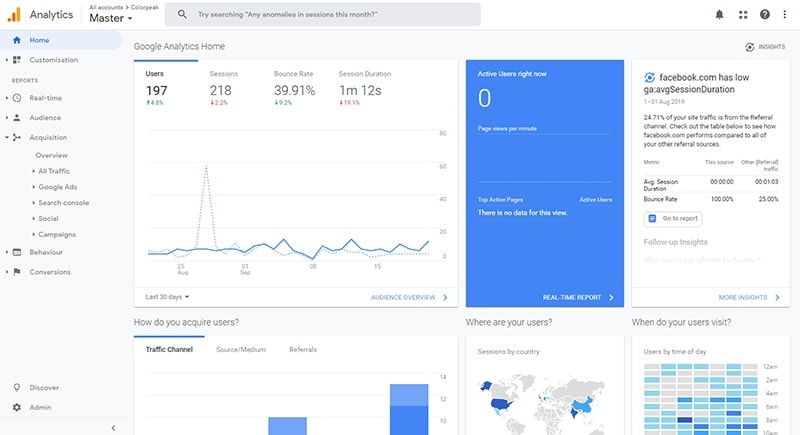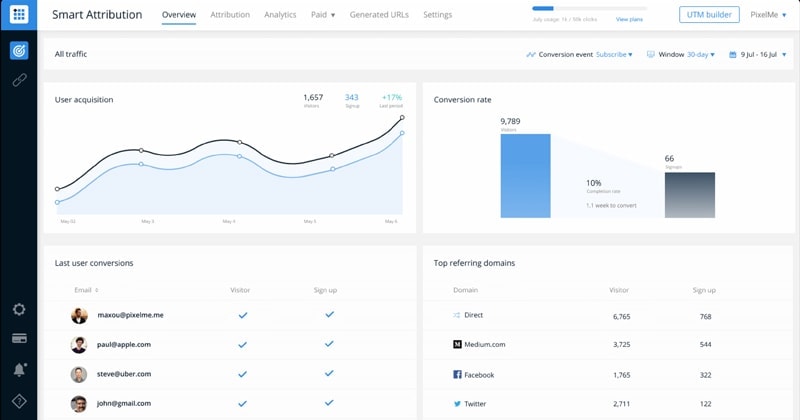Whether you like it or not, savvy-marketeers and modern businesses use pixel ad tracking to tailor their products and services to sell more, serve better and grow faster. It is then not surprising that several companies built entire businesses to serve just this single purpose – tracking you. Web analytics are a must these days and tracking user behaviour cannot be guesswork if you want to optimise your ads.

Marketing Analytics – the Key to Your Company Success
Nowadays, you can find many tracking and marketing automation tools to provide an almost infinite amount of data to track users and user behaviour. Most heard of (or used) is Google Analytics and their pixel tracking– a staple among online marketing communities. And Google’s Secret Weapon used to dominate the Digital World (ever asked yourself why such a sophisticated marketing tool is… free?). Some even go as far as to say it ruined the marketing.
Whatever your opinion is, Analytics is a powerful piece of marketing software for conversion tracking that you shouldn’t underestimate. But does it end there? Certainly not!
Google Analytics – The Easiest Most Difficult Marketing Tool to Implement
One of the Analytics problems is its interface and complexity. Or its ‘sandboxiness’. Google indeed puts all the effort to make it super-easy for virtually everyone to plaster their tool on their websites. But once it’s there and you enter Analytics, it kind of leaves you hanging. It takes a lot of time and knowledge to understand the jargon, the mechanics of the tool, and how to set things up like tracking pixel or conversion tracking for yourself – not only on your website but also on the overview dashboard. We’ve seen many business owners withdraw to just tracking… traffic instead of tracking user behaviour. Or whatever the default GA dashboard shows. With many not even understanding what “Bounce Rate” is.
I once had someone ask me why their website “got only 43% of the “bouncy score” – thinking it’s Google’s “Coolness” metric of some sort… Indeed, the “Bouncy Score” should be the next big (bouncy) thing in internet marketing.
PixelMe – Going Beyond Google Analytics
No wonder many marketers took their expertise in data analysis to and decided to build a tool that gave their own spin around Pixel Ad tracking and business intelligence. One of those tools is PixelMe.
Folks at PixelMe looked at all that GA-sandbox confusion and decided to just cut to the chase. “What do marketers and website owners need to really know from people visiting their websites?”. They created a tool that is 100x easier to understand, navigate around, and implement than Google Analytics ever has been. And it’s great!
How does a pixel tracker work?
To better understand Pixel ad tracking, first, you need to understand what a tracking pixel is. In a majority of cases, it is a code snippet that is triggered when a visitor lands on your website, clicks on a link or opens an email. The pixel script communicates with the source server, which registers a user-triggered action. Meanwhile, the user is “tagged” with a unique ID, and the entire website session gets recorded in “a browser cookie” file.
It is worth noting that the Internet browsers refer back to cookie files every time users come back to websites. And, as you already suspect, the pixel server is then getting informed as well.
For example, every click made by the user can be captured and tracked so you can adjust your conversion actions. In other words, tracking pixel allows you to gather data to improve your digital ad and marketing strategy. All that is based on the user behaviour tracking data that is provided by a pixel code. By collecting all that data about user behaviour, you can optimise your ads, content and improve retargeting.
Here are Top 5 things to set up in PixelMe to effectively utilise Pixel ad tracking tool:
- Retargeting (re-marketing) via Short-Links – you can develop super-effective retargeting audience groups from any link you share. PixelMe starts as a web-link shortener but then allows you to incorporate them with advertisement retargeting pixels, attributions and various marketing automation hacks.
- Assign Urchin Tracking Module (UTM) – with the ability to include UTM tags to all your web links you will know where every website conversion comes from. When used in your marketing campaigns, you can further evaluate and also enhance your financial investments through the first touch, multi-touch, or last touch attribution versions.
- Serve as your All-in-One Marketing Platform – PixelMe automatically combines data from multiple platforms in one convenient dashboard. Within few minutes, you can plug most of your ads’ systems (Facebook, Google, etc.), many CRM platforms, as well as various analytics platforms (like Segment or Google Tag Manager).
- Test and decide what works for you – test and see which of your marketing channel brings the highest ROI and which should you abandon. Because PixelMe allows you to measure the influence of any kind of paid or natural network, you no longer have to guess if a given investment is worth throwing money at it.
- Map your customer journeys – all that data means nothing if you can’t test your assumed touchpoints and paths to conversion. PixelMe allows you to look at each customer touchpoint and help you to understand its contribution in making or breaking the sale.
Business Analysis, Marketing Attribution And Tracking – Making It All Count
The one thing shared among many business marketers (and especially social media influencers) is the obsession with data hoarding. Everyone seems to obsess around clicks, likes, followers, subscribers… But not many take it to the next level and ask a question – “what it all really means to my business?!“. Because so many of those “stats” are just completely arbitrary. We call them the “Vanity Metrics” for a reason. But thanks to marketing tools like PixelMe, we can look at the pixel ad tracking data and the real-world examples that it provides. And then take an information-based action. If you dig deep enough, you may even find your own “Bouncy Score”.



